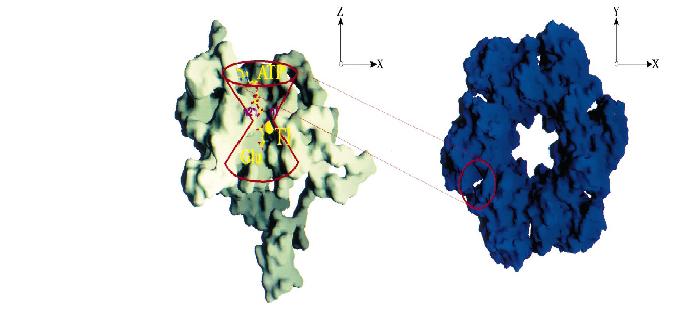User:Grace Natalie
From Proteopedia
| Line 10: | Line 10: | ||
bacteria to introduce reduced nitrogen into cellular metabolism. GS is a dodecamer formed from | bacteria to introduce reduced nitrogen into cellular metabolism. GS is a dodecamer formed from | ||
two face-to-face hexameric rings of subunits, with 12 active sites formed between monomers | two face-to-face hexameric rings of subunits, with 12 active sites formed between monomers | ||
| - | <ref name="Book">Gill, H & Eisenberg, D., Biochemistry 2001 40: 1903-1912</ref> | + | <ref name="Book">Gill, H & Eisenberg, D., Biochemistry 2001 40: 1903-1912</ref> .</font> |
| - | + | ||
| - | + | ||
| - | + | ||
| - | + | ||
<br><br> | <br><br> | ||
<center><font size=4 face ="Arial">Overall Reaction of Glutamine Synthetase</font></center> | <center><font size=4 face ="Arial">Overall Reaction of Glutamine Synthetase</font></center> | ||
| Line 23: | Line 19: | ||
<font size=2>The first step is the formation of the activated intermediate γ-glutamyl phosphate. | <font size=2>The first step is the formation of the activated intermediate γ-glutamyl phosphate. | ||
The n2 ion coordinates the phosphate oxygens of ATP to allow phosphoryl transfer to the | The n2 ion coordinates the phosphate oxygens of ATP to allow phosphoryl transfer to the | ||
| - | γ-carboxylate group of glutatmate, | + | γ-carboxylate group of glutatmate, yielding the intermediate <ref name="Eisenberg">D. Eisneberg et al / Biochimica et Biophysica Acta 1477 (2000) 124</ref> . The second step is the attack on the intermediate by ammonia |
| - | attack on the intermediate by ammonia therefore releasing free phosphate to yield glutamine.</font> | + | therefore releasing free phosphate to yield glutamine.</font> |
<br><br> | <br><br> | ||
<font size=4 face ="Arial">ATP binding site</font> | <font size=4 face ="Arial">ATP binding site</font> | ||
<br> | <br> | ||
| - | <font size=2><scene name='User:Grace_Natalie/Atp_binding_site2/2'>ATP | + | <font size=2>Each active site of GS is described as a 'bifunnel in which ATP and glutamate bind at opposite ends. |
| - | + | The <scene name='User:Grace_Natalie/Atp_binding_site2/2'>ATP binding site</scene> is referred to as the top of | |
| - | + | the bifunnel because it opens to the external 6-fold surface of GS (figure below) <ref name="Eisenberg"/>. | |
| - | + | At the the joint of the bifunnel are two cation binding sites, n1 and n2, where either magnesium or manganese bind | |
| - | + | for catalysis. The n2 ion is involved in the phosphroyl transfer, while the n1 ion stabilizes an active GS and plays a role in binding glutamate <ref name="Eisenberg"/> . | |
| + | |||
<center>[[Image:Untitled.JPG]]<br> | <center>[[Image:Untitled.JPG]]<br> | ||
<font size=2>D. Eisneberg et al / Biochimica et Biophysica Acta 1477 (2000) 124</font></center> | <font size=2>D. Eisneberg et al / Biochimica et Biophysica Acta 1477 (2000) 124</font></center> | ||
Revision as of 04:09, 22 December 2008
|
Background
Glutamine synthetase (GS) catalyzes the ATP-dependent condensation of ammonia and
glutamate to yield glutamine, ADP, and inorganic phosphate in the presence of divalent cations
[1] .
The reaction occurs in two steps with γ-glutamyl phosphate as an intermediate and is used by
bacteria to introduce reduced nitrogen into cellular metabolism. GS is a dodecamer formed from
two face-to-face hexameric rings of subunits, with 12 active sites formed between monomers
[2] .
Overall Mechanism
The first step is the formation of the activated intermediate γ-glutamyl phosphate.
The n2 ion coordinates the phosphate oxygens of ATP to allow phosphoryl transfer to the
γ-carboxylate group of glutatmate, yielding the intermediate [3] . The second step is the attack on the intermediate by ammonia
therefore releasing free phosphate to yield glutamine.
ATP binding site
Each active site of GS is described as a 'bifunnel in which ATP and glutamate bind at opposite ends.
The is referred to as the top of
the bifunnel because it opens to the external 6-fold surface of GS (figure below) [3].
At the the joint of the bifunnel are two cation binding sites, n1 and n2, where either magnesium or manganese bind
for catalysis. The n2 ion is involved in the phosphroyl transfer, while the n1 ion stabilizes an active GS and plays a role in binding glutamate [3] .

D. Eisneberg et al / Biochimica et Biophysica Acta 1477 (2000) 124
Involving Residues
Most residues involved in enzymatic catalysis are located at the C domain but Asp50 is
contributed from the N domain of the other subunit. The binding of ADP induces Asp50 in order to
enhance the ammonium binding, and then to deprotonate the ammonium ion to form the active ammonia
to attack the gamma-glutamyl phosphate.
| Residue | Role in enzymatic mechanism |
| Arg-321 | Coordinates the carboxylate of glutamate |
| Glu-327 | Closes active site and shields intermediate from hydrolysis |
| His-269 | Coordinates the n2 ion |
| Glu-220 | Coordinates the n1 ion |
| Asp-50 | Increases the affinity for ammonium binding |
References
- ↑ 1.0 1.1 Liaw, S-H, et.al.,Discovery of the ammonium substrate site on glutamine synthetase, a third cation binding site Protein Sci. 1995 4: 2358-2365
- ↑ Gill, H & Eisenberg, D., Biochemistry 2001 40: 1903-1912
- ↑ 3.0 3.1 3.2 D. Eisneberg et al / Biochimica et Biophysica Acta 1477 (2000) 124
